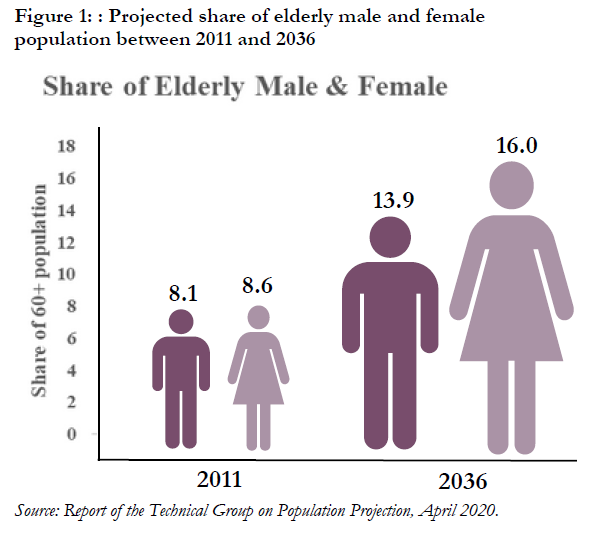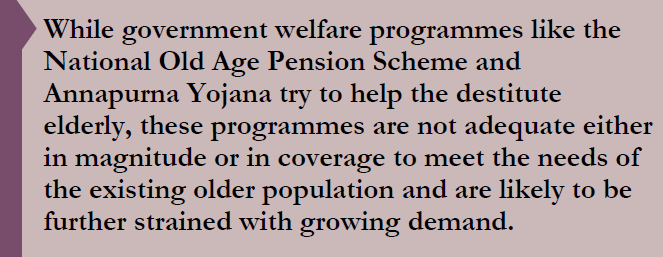

Gender lays a significant role in the ageing process. Men and women age differently. The consequences of the differential ageing process on men and women are not limited to financial issues alone but stretch further to their relative position in the family, their physical and mental health, care needs, etc. Stuckelberger (1997) noted that “Women everywhere are living longer than men, but the longevity of women is offset by a higher sickness rate than that of men; women suffer more from non-lethal diseases”.
The most significant manifestation of exclusive concern with women when considering gender and ageing was evident in the Madrid International Plan of Action on Ageing, emanating from the Second World Assembly on Ageing sponsored by the United Nations in 2002 (United Nations, 2002). The Plan explicitly advocated “the integration of a gender perspective into all policies, programmes and legislation” dealing with ageing (United Nations, 2002: paragraph 8) and also made it clear that “the situation of older women everywhere must be a priority for policy actions.”
The gradual improvements in mortality conditions have helped avert premature adult deaths in India, leading to a rise in life expectancy among the population. According to the United Nations, India became the world’s most populous country in April 2023, surpassing China’s population of 1.41 billion. This comes with a sharp rise in its older population. The share of the elderly aged 60 years and above went up from 7.4% in 2001 to 8.6% in 2011. The report of the Technical Group on Population Projections (2020) projected this figure will further increase to 15.0% by 2036. During this period, while both the elderly males and females will more than double in number, the growth will be much higher for females than males (Figure 1).
 While ageing itself poses enormous challenges to society like increasing economic dependency and care needs, its impact varies between males and females. Higher levels of widowhood and associated socio-cultural and economic deprivations (International Institute for Population Sciences, 2023) leads to feminisation of ageing (higher share of women than men among the elderly) in old age.
While ageing itself poses enormous challenges to society like increasing economic dependency and care needs, its impact varies between males and females. Higher levels of widowhood and associated socio-cultural and economic deprivations (International Institute for Population Sciences, 2023) leads to feminisation of ageing (higher share of women than men among the elderly) in old age.
There has been an increasing trend towards independent living, and many older person across the world live alone (Bennett & Dixon, 2006). The trend of independent living is much more common in developed countries that have stronger social safety nets and public support systems for the elderly. However, there remains important differences in gender, age and marital status of older persons who live alone (United Nations, 2005). The trend of living alone has also been increasing in Asian countries (Yeung & Cheung, 2015). The family remains the major source of economic and social support for the elderly in India. However, the social fabric has changed with globalisation, leading to migration and a decline in joint families (Niranjan et al., 2005; Shah, 2005). The prevalence of one-person households is low in India compared to other Asian countries. However, the share of these households is rising continuously. Between 2001 and 2011, the number of one-person households in India increased from 7 million to 9 million (nearly 4% of all ‘normal’ households which excludes houseless and institutional households) (Dommaraju, 2015) and was expected to increase to 5.5% in 2030 and 6.7% in 2050 (Purkayastha et al., 2022). In 2007–08, the majority of those living in one-person households were aged over 55, female and widowed, divorced or separated, lived in rural areas and did not own a house.
Fertility decline has also contributed to a gradual rise in one-child households and daughter-only households. Given the reliance on sons for financial and residential support in India, the decline in the presence of sons poses an additional challenge. As a result, Sahoo and Nagarajan (2020) observed an increasing trend in daughter preference in both high and low son-preference states in India.
Elderly, widowed women are often left with little support and also experience greater incidence of morbidities that are functionally restricting (Dommaraju, 2015). Chen (1997) portrayed a grim picture of widowed Indian women, who face social and economic exclusions after the death of their spouse. Yan et al. (2024) reported that the ownership of and control over agricultural family land in rural India was rare among elderly women, which was associated with lower decision-making power on household affairs. Chattopadhyay et al. (2022) noted that vulnerable (i.e., rural, living alone, divorced/separated) elderly females work more than their male counterparts.
Along with these socio-economic disadvantages, elderly women in India face a significant health burden. Apart from non-communicable diseases like hypertension, heart disease, and diabetes, they also suffer from various health issues as a result of poor reproductive health during their childbearing years (Lee et al., 2014; Pradhan et al., 2023). Lower levels of investments in human capital like in nutrition and education during early life among women are associated with a female disadvantage in late-life health and well-being (Angrisani et al., 2020; Pati et al., 2023).
 This issue of GenderTalk brings together some of the scholarly work on gender and ageing in the Indian context. The articles cover issues like living arrangements, widowhood, time use, and the health of elderly Indians through a gender lens. While government welfare programmes like the National Old Age Pension Scheme and Annapurna Yojana try to help the destitute elderly, these programmes are not adequate either in magnitude or in coverage to meet the needs of the existing older population and are likely to be further strained with growing demand. To confront the challenges that elderly women face in India needs a multi-sectoral approach. In the Conversation section of this issue, we have also incorporated experiences of one of the few civil society organisations working to support the elderly population, HelpAge India.
This issue of GenderTalk brings together some of the scholarly work on gender and ageing in the Indian context. The articles cover issues like living arrangements, widowhood, time use, and the health of elderly Indians through a gender lens. While government welfare programmes like the National Old Age Pension Scheme and Annapurna Yojana try to help the destitute elderly, these programmes are not adequate either in magnitude or in coverage to meet the needs of the existing older population and are likely to be further strained with growing demand. To confront the challenges that elderly women face in India needs a multi-sectoral approach. In the Conversation section of this issue, we have also incorporated experiences of one of the few civil society organisations working to support the elderly population, HelpAge India.
References
Angrisani, M., Jain, U., & Lee, J. (2020). Sex differences in cognitive health among older adults in India. Journal of the American Geriatrics Society, 68, S20-S28.
Bennett, J., & Dixon, M. (2006). Single person households and social policy: Looking forwards. Joseph Rowntree Foundation.
Census of India (2011): “Population Projections for India and States 2011 – 2036”, A Report of National Commission on Population, Published in April, 2020.
Chattopadhyay, A., Khan, J., Bloom, D. E., Sinha, D., Nayak, I., Gupta, S., Lee, J., & Perianayagam, A. (2022). Insights into labor force participation among older adults: Evidence from the longitudinal ageing study in India. Journal of Population Ageing, 15(1), 39-59.
Chen, M. A. (1997). Listening to widows in rural India. Women: A cultural review, 8(3), 311-318.
Dommaraju, P. (2015). One-person households in India. Demographic Research, 32, 1239-1266.
International Institute for Population Sciences (2023). India Ageing Report 2023, Caring for Our Elders: Institutional Responses. UNPF.
Lee, J., Shih, R., Feeney, K., & Langa, K. M. (2014). Gender disparity in late-life cognitive functioning in India: findings from the longitudinal aging study in India. Journals of Gerontology Series B: Psychological Sciences and Social Sciences, 69(4), 603-611.
Niranjan, S., Nair, S., & Roy, T. (2005). A socio-demographic analysis of the size and structure of the family in India. Journal of Comparative Family Studies, 36(4), 623-652.
Pati, S., Sinha, A., Verma, P., Kshatri, J., Kanungo, S., Sahoo, K. C., Mahapatra, P., Pati, S., Delpino, F. M., & Krolow, A. (2023). Childhood health and educational disadvantage are associated with adult multimorbidity in the global south: Findings from a cross-sectional analysis of nationally representative surveys in India and Brazil. J Epidemiol Community Health, 77(10), 617-624.
Pradhan, M. R., Mondal, S., & Mudi, P. K. (2023). Gynecological morbidity and treatment-seeking among older adult (aged 45–59) women in India. Reproductive Health, 20(1), 64.
Purkayastha, N., Dhillon, P., Ali, B., & Hazarika, J. (2022). Changing Patterns of One-Person and One-Couple-Only Households in India. Journal of Population Ageing, 1-19.
Sahoo, H., & Nagarajan, R. (2020). “Daughter-Only” Families in Selected High and Low Son Preference States in India: A Comparative Analysis. Indian Journal of Human Development, 14(2), 234-256.
Shah, A. (2005). Family studies: Retrospect and prospect. Economic and Political Weekly, 19-22.
Stuckelberger, A. (1997). Men and women age differently. World Health, 50(4), 8-9.
United Nations. (2002). Report of the Second World Assembly on Ageing: Madrid, 8-12 April 2002. New York: United Nations.
United Nations, Department of Economic and Social Affairs, Population Division (2005). Living Arrangements of Older Persons Around the World. New York: United Nations. Sales No. E.05.XIII.9.
Yan, H. X., Desai, S., & Barik, D. (2024). Gender and Generation: Landownership and Older Indians’ Autonomy. Feminist Economics, 30(1), 172-210.
Yeung, W.-J. J., & Cheung, A. K.-L. (2015). Living alone: One-person households in Asia. Demographic Research, 32, 1099-1112.
_____________________________
Dr. Debasis Barik, Senior Fellow at the NCAER National Data Innovation Centre, is an esteemed demographer specialising in economic demography and the environmental adaptation of Indian households. His influential research, featured in prestigious journals like World Development, Health Economics, etc., contributes to key large scale surveys including IHDS.